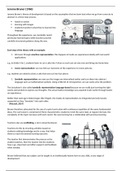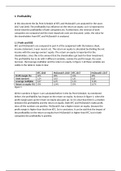5.1 – Hazards in a geographical context
Hazard: a threat of substantial loss of life, substantial impact upon life or damage to
property that can be caused by an event.
Hazardous event: the occurrence of an event which impacts an area socially, economically
and environmentally.
Disaster: when a hazard seriously affects humans (normally large scale) which threaten
many people and properties - occurs as a result of a hazard (combination of a vulnerable
population and a natural hazard always causes disaster)
Caused by:
Human actions: explosions, chemical release into the atmosphere, nuclear incidents
Natural events: earthquakes, tropical storms, volcanoes, wildfires
can be in response of human actions
Impacts of natural hazards:
- Damage to property
- Loss of life
- Impact on life
3 main types of hazards:
1. Geophysical – driven by Earth’s own internal energy sources (tectonic plates, volcanoes)
2. Atmospheric – driven by processes at work in the atmosphere (droughts, storms)
3. Hydrological – driven by water bodies (oceans, floods, tsunamis, storm surges)
Impacts:
Primary: have an immediate effect on the affected area (e.g. destruction of
infrastructure)
Secondary: happen after the disaster has occurred (e.g. disease, economic recession)
What determines the severity of a hazard?
1. Duration: the length of time that a hazard lasts for
2. Magnitude: the strength of the hazard
3. Predictability: whether there are signals of warning
4. Regularity: how often they happen
5. Frequency: the return interval between hazards
6. Speed of onset: how quickly they happen
7. Spatial concentration: location
8. Area extent: what area they cover
9. Number of hazards: if a location is hit by multiple
Hazard: a threat of substantial loss of life, substantial impact upon life or damage to
property that can be caused by an event.
Hazardous event: the occurrence of an event which impacts an area socially, economically
and environmentally.
Disaster: when a hazard seriously affects humans (normally large scale) which threaten
many people and properties - occurs as a result of a hazard (combination of a vulnerable
population and a natural hazard always causes disaster)
Caused by:
Human actions: explosions, chemical release into the atmosphere, nuclear incidents
Natural events: earthquakes, tropical storms, volcanoes, wildfires
can be in response of human actions
Impacts of natural hazards:
- Damage to property
- Loss of life
- Impact on life
3 main types of hazards:
1. Geophysical – driven by Earth’s own internal energy sources (tectonic plates, volcanoes)
2. Atmospheric – driven by processes at work in the atmosphere (droughts, storms)
3. Hydrological – driven by water bodies (oceans, floods, tsunamis, storm surges)
Impacts:
Primary: have an immediate effect on the affected area (e.g. destruction of
infrastructure)
Secondary: happen after the disaster has occurred (e.g. disease, economic recession)
What determines the severity of a hazard?
1. Duration: the length of time that a hazard lasts for
2. Magnitude: the strength of the hazard
3. Predictability: whether there are signals of warning
4. Regularity: how often they happen
5. Frequency: the return interval between hazards
6. Speed of onset: how quickly they happen
7. Spatial concentration: location
8. Area extent: what area they cover
9. Number of hazards: if a location is hit by multiple











